16 October, 2003
The morning looked iffy-gray skies, flat light, clouds obscuring the
horizon. We called to check on the possibility of setting up our
camp today and found, much to our surprise, that the crews were
already down in the transition zone hooking up our orange fish huts
to the tractor. After all the delays, it was surprising to find out
it was actually happening. Luckily, we'd all packed our bags days
before, in hopes that eventually the weather would clear. We dragged
our things to the Crary Lab to load them in the Pisten Bully, along
with the rest of our seal tagging equipment. On top of this we put
the canned goods and dried foods we'd gotten earlier in the week and
stored indoors so they wouldn't freeze. Then it was down to the
transition zone to fire up the snow machines and head out to Big
Razorback Island to be there when the camp was set up.
We followed the flagged road across the sea ice that leads to Cape
Evans and Cape Royds (at the edge of the sea ice). Darren, Kelly,
and Mark blazed ahead to pass the wagon train of orange huts, while
Gillian stayed behind to keep track of the snowmobile neophyte (that
would be me). It's hard to believe, but is quite true; even after
almost 25 years of living in Utah and Colorado, I have never driven a
snowmobile until today. So that was definitely the first excitement
of the day. The snowmobiles have heated handgrips-but I am sure that
I was gripping mine too hard to even fell any of the warmth! But
hey, rev up the engine and rock and roll-it's time to learn to drive
yet another new vehicle. Just past Big Razorback Island we left the
relative smoothness of the 'road' and took off across the snow and
ice to reach our camp, which is strategically placed in the lee side
of the island.
Shortly after our arrival the set-up crew arrived. Our huts were set
into position. The kitchen hut was placed first, to ensure that it
would have the premier view of Mt. Erebus. We have 4 huts-a kitchen,
lab, and 2 for sleeping. Each is equipped with a propane heater.
The kitchen has two, 2-burner Coleman propane stoves and a
well-stocked pantry. We store our frozen foods outside (hey-it's
Antarctica) in coolers and boxes. We don't have to worry about
critters getting into our food here! It's more important to make
sure the coolers and boxes are securely tied down to prevent
unplanned flights during high winds. The bunk beds in the sleeping
huts are equipped with insolate pads, an extra-thick thermarest
inflatable mattress, and warm sleeping bags with fleece liners.
Once the buildings were in place it was time for, perhaps, the most
important job-setting the outhouse into position. First, a hole was
drilled through the sea ice. The outhouse is mounted onto skids that
allow it to be dragged into position over the hole. Then small
v-holes (remember sea ice school when we drilled holes to anchor our
tents?) were drilled at the two ends of the outhouse, and ropes were
tied to anchor the outhouse firmly to the ice. It just wouldn't do
to run the risk of unexpectedly flying north to New Zealand during a
trip to the outhouse! Our outhouse is quite deluxe-there's ample
room to maneuver while wearing multiple layers of bulky clothes, as
well as coat hooks and even a book rack. I must say, however, that
it is a bit chilly to linger there while the ambient temperatures
hover near zero.
Once the physical set-up was completed, the electric crew arrived to
hook up our power. The kitchen hut is equipped with a roof-mounted
photovoltaic panel that produces electricity for our camp. Lines
were run between the kitchen and the lab hut. The electricity
generated by the panels is stored in a series of batteries stored
inside the kitchen hut. We also have a generator that we can use to
charge the batteries if we are beset by a multi-day storm that keeps
the system from charging. Now we are waiting for the telephone to
get hooked up. Once this is done, we will be able to call McMurdo as
well as access the Internet through the McMurdo phone line (and I'll
be able to continue sending my journals and pictures to the TEA
website).
Amazingly enough, once our camp was set up, the sun came out. I saw
mountain ranges I had not seen since we arrived in Antarctica. The
views are incredible-the Royal Society Range of the TransAntarctic
Mountains to the west, Mt. Erebus to the east, and rocky islands
jutting up through the ice behind us and to the north. We took time
in the afternoon to visit some of our neighbors-Weddell Seals that
come up onto the ice through the crack that parallels Big Razorback
Island. We saw a few pups and mothers as well as a female that
looked like she could have her pup at any moment. Tomorrow we will
begin tagging the newborn babies and any other seals that are either
untagged or have broken or missing tags.
We ended the day with a beautiful sunset over the Royal Society Range
and a toast to our new home. It's taken 2 1/2 weeks since we left
home and we're ready to begin work.
Daily Haiku:
Leaving McMurdo
Camp's set up, the heat is on
Meet our new neighbors
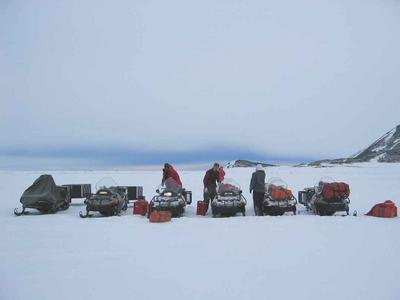
Getting ready to leave McMurdo
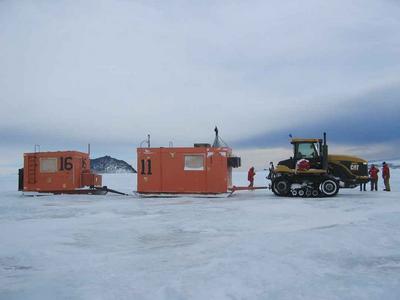
Pulling the huts into position
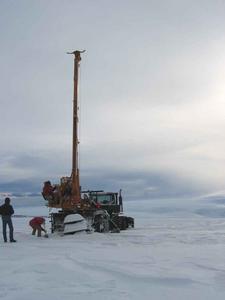
Using the industrial drilling technique for....

Setting up the outhouse--now it just needs to be tied down.

The kitchen is well-stocked
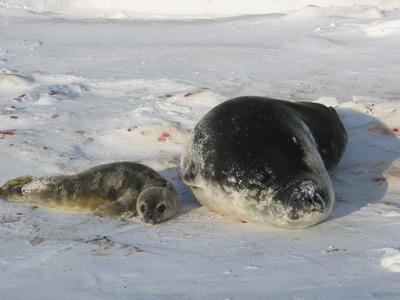
Here's our neighbors
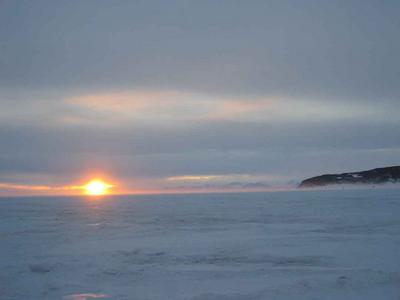
A beautiful end to a great day
Contact the TEA in the field at
.
If you cannot connect through your browser, copy the
TEA's e-mail address in the "To:" line of
your favorite e-mail package.
|
